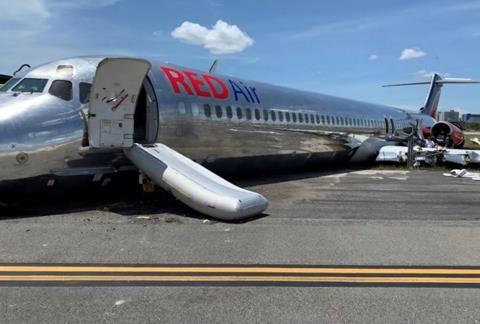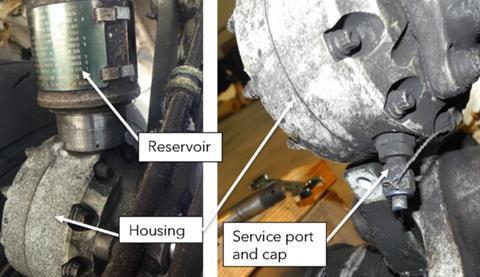US investigators have attributed a Red Air Boeing MD-82’s main landing-gear collapse and runway excursion to ineffective shimmy dampening during roll-out, after the jet touched down in Miami.
The aircraft had been arriving from Santo Domingo, in the Dominican Republic, on 21 June 2022.
It landed on runway 9 but, as it rolled out, its left main landing-gear downlock suffered a structural failure and the gear assembly collapsed. The jet veered into grass on the left side of the runway, and collided with a concrete structure.
All 140 occupants survived, with only a handful of minor injuries, although the aircraft was badly damaged from the impact as well as a fire which broke out during evacuation.

Analysis by the US National Transportation Safety Board found that, some 1,300ft after touchdown, tyre marks on the runway showed evidence of shimmy on the left main gear.
Shimmy is a vibration phenomenon in which the inner landing-gear cylinder oscillates relative to the outer cylinder, and can occur during heavy braking or high-speed taxiing.
Excessive build-up of this vibration is prevented by a shimmy damper on the aft side of the landing-gear leg, between the upper and lower torque links. It features a reservoir of hydraulic fluid atop the damper housing, which serves to restrict movement of a piston in the damper chamber, quelling the vibration.
The left main-gear assembly was not due for overhaul until August 2026 – unless it reached 55,400 cycles beforehand – but the shimmy dampers were required to be checked visually every three days.
Red Air’s maintenance programme also featured a shimmy-damper check during an ‘S’ service which involved a walk-round inspection and which was carried out on 20 June, the day before the accident.
Maintenance records “showed no anomalies” during the last shimmy-damper check, says the inquiry.

Examination of the shimmy damper found it was assembled correctly. But the inquiry determined that its check valve was leaking, and a cap for its service port was missing.
Since the shimmy damper had been operating for a year since its last service, the inquiry believes the check-valve leak had “silently developed” and was “sitting latent” until a problem with the service-port cap occurred.
Given that the shimmy damper passed the ‘S’ check a day earlier, the inquiry suggests the cap must have been present and the hydraulic fluid level was sufficient – concluding that the cap either went missing or was compromised in the subsequent 24h period, during which the aircraft conducted two flights.
“After the service-port cap failed, sufficient fluid likely leaked from the damper through the leaking check valve and the uncovered service port in the hours prior to the accident, ultimately compromising the functionality of the shimmy damper,” it states.
But it adds that the damage from the gear collapse “limited” the inquiry’s ability to determine whether the damper was properly services, and understand definitively the root cause of the apparent check-valve and service-port cap failures.
Investigators also found insufficient evidence to establish any contribution relating to the operator’s organisational oversight or regulatory oversight of maintenance activity.


























